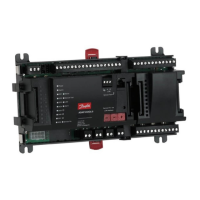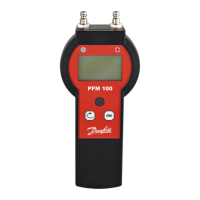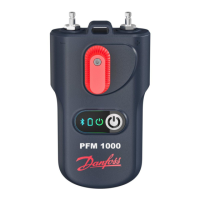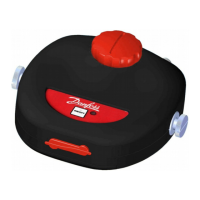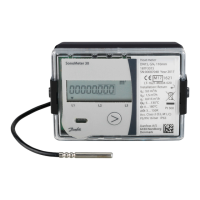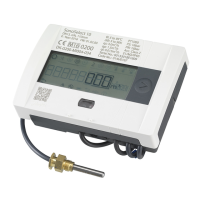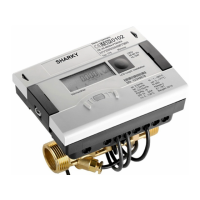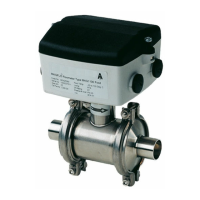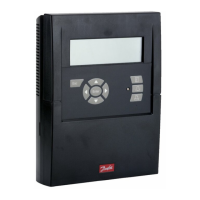
Do you have a question about the Danfoss AK-SM 350 and is the answer not in the manual?
| Display | LCD |
|---|---|
| Input Voltage | 24 V AC/DC |
| Communication Protocol | Modbus RTU |
| Relay Outputs | 4 |
| Enclosure Class | IP 20 |
| Accuracy | ±0.5 °C |
| Power Supply | 24 V AC/DC |
| Electrical Connection | Screw terminals |
| Material | Plastic |
| Output Signal | 4-20 mA |
| Process Connection | G1/2" |
| Storage Temperature | -40°C to +70°C |
Details the various inputs and sources for readings the AK-SM 350 can monitor.
Explains how the unit signals alarms and routes them to external destinations.
Describes how data points are recorded, saved, and retrieved.
Details connections for modem, Ethernet, and PC.
Explains how to access the menu system for setups.
Explains the use of arrow keys and Enter for navigation and selection.
Details the overview display showing all defined readings with symbols.
Shows actual values, limits, and access to graph for a specific point.
Describes actions taken when the alarm button is pressed.
How to access and view the history of past alarms.
Details electrical supply, connections, and relay specifications.
Details data logging intervals, capacity, and battery backup.
Details the number of relays and their maximum load.
Ordering information for the AK-SM 350 unit.
Ordering information for the m2+ expansion module.
Instructions for opening and closing the unit's cover.
Guidelines for optimal placement of the unit for visibility and performance.
Explains the principle of connecting various devices to the AK-SM 350.
Provides a summary of all connection points and their uses.
Describes the functions and connections for Relay 1.
Explains how to connect sensors to the terminal block.
How to connect and configure the m2+ expansion module.
Instructions for connecting and addressing a GD gas detector.
How to address EKC controllers for communication.
How to connect a PC for setup, service, and data retrieval.
How to connect via Ethernet/TCP/IP for setup and service.
Step-by-step guide for configuring the monitoring unit.
Instructions for configuring individual measuring points.
Testing alarm functionality and destination delivery.
Explanation of the unit's display screens and navigation.
Details the overview display showing all defined readings with symbols.
Shows actual values, limits, and access to graph for a specific point.
Explanation of the graph display for historical data.
Accesses functions for daily operation like defrost and PO optimisation.
Accesses basic setups for individual points and functions.
Configuration for day and night time settings and their effects.
Setting store opening and closing times for alarm routing.
Defines groups of controllers for coordinated or individual defrost.
Setting up the timing for defrost cycles.
Selecting groups of controllers for PO optimisation.
Adjusting suction pressure offset for PO optimisation.
General configuration settings like language and site name.
Function to scan and register connected controllers.
Setting a password for service access.
Setting the current date and time.
How to select a specific point for setup.
Defining the type of reading for a point (e.g., Temperature).
Setting the upper limit for temperature alarms.
Setting the lower limit for temperature alarms.
Setting the delay time before a temperature alarm is triggered.
Setting the priority for high temperature alarms.
Setting the priority for low temperature alarms.
Defining signal type as voltage or current.
Setting displayed value for the highest input signal.
Configuring contact function for digital inputs (active at closed/open).
Configuring pulse counting settings for power meters.
Applying a scaling factor for power meter readings.
Information on how the defrost function works and its relation to alarms.
Monitors refrigerant concentration and generates alarms.
Settings for points configured as controllers.
Setting alarm limits for individual controllers.
Collecting daily or weekly power meter readings.
Setting the frequency for plotting log values.
General settings for alarms, modem, and 'I'm alive alarm'.
Setting the number of alarm routes.
Testing alarm routes and destinations.
Description of alarm route settings, including destinations.
Dividing alarms based on store opening/closing times.
Setting primary destinations for alarms.
Overview and settings for remote alarm destinations.
Configuring the unit's internal buzzer for alarms.
Setting up SMS destinations for alarms.
Settings for modem connections to remote destinations.
Settings for Ethernet connections to remote destinations.
Configuring buzzer settings (mode, auto mute time).
Setting up the first SMS destination, including phone number.
Selecting printout format (Graph or Table).
Configuring data averaging for concentrated printouts.
Configuring IP address mode, host name, IP address, and subnet mask.
Configuring the relay for modem on/off function.
Configuring the watchdog function and relay activation.
Configuring Alarm Relay A with priority, mode, and schedule.
Defining how the relay behaves during an alarm.
Displaying and managing active alarms.
Accessing and viewing the history of past alarms.
Accessing the print menu for data collection.
Option to print the current state of all points.
Selecting a point to view its temperature graph.
Adjusting the store's opening and closing times.
Adjusting the specific times for defrost cycles.
Connecting the service tool AK-ST 500 to the AK-SM 350.
Creating a new template for controller displays.
General steps for setting up template display sections.
Choosing a parameter within the selected section's properties.
Configuring the primary display area, e.g., appliance temperature.
Configuring secondary display for alarm limits and delays.
Accessing and configuring the "More details" display section.
Retrieving and reusing text entries in new templates.
Overview of options under Point overview.
Overview of options under Network list.
Overview of options under Plant control.
Overview of options under Service Setup.
Overview of options under Alarm setup.
Overview of options under Print setup.
Overview of options under IP setup.
Overview of options under Relay setup.
Information on the manual's validity and software version.
